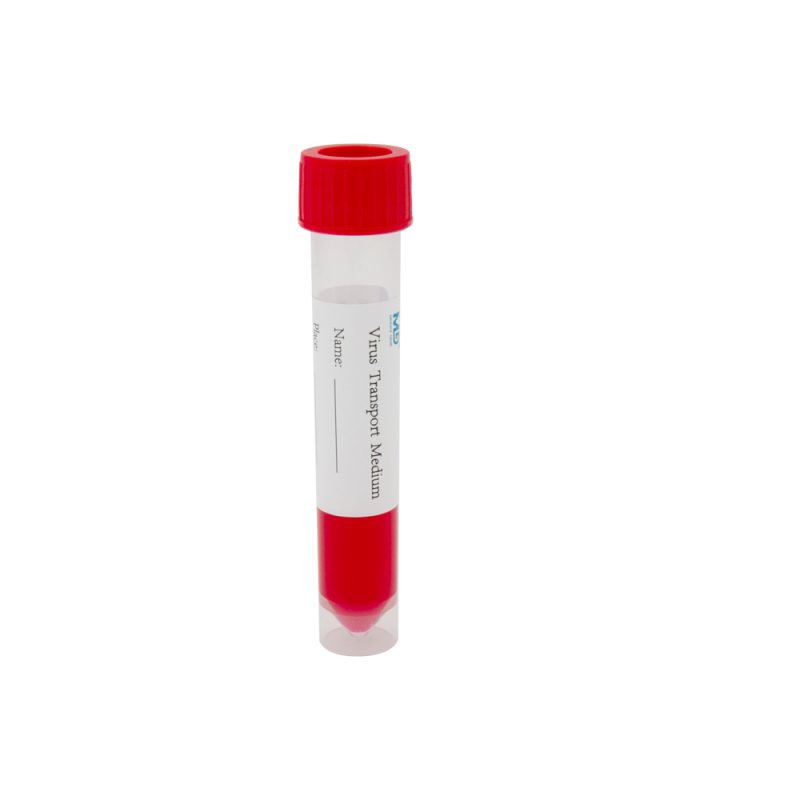Es gibt viele Einweg Probenröhrchen für Viren auf dem Markt, Aber die Qualität ist auch ungleichmäßig. Zu den häufigen Qualitätsproblemen gehören: Probenkonservierungslösung Leckage, Rohrabdeckungsschäden, Probenkonservierungslösung Verfärbung, Etikettablösung, etc. Das Virus -Probenahmrohr ist ein Behälter für die Lagerung von Proben, und sein Qualitätsproblem wirkt sich direkt auf die Ergebnisse des Nukleinsäuremittels aus. So, Worauf sollten wir bei der Auswahl eines Einweg-Virus-Probenahmrohrs achten??

1. Materialeignung. Gemäß den Implementierungsrichtlinien von Nukleinsäuretestinstitutionen, Es gibt klare Anforderungen an Materialien, „Die Kappe und der Rohrkörper sollten aus Polypropylenmaterial bestehen, Der Schraubmund kann versiegelt werden, Die Versiegelungsleistung ist moderat, und die Dichtung ist im Inneren bedeckt, das ist resistent gegen ein Gefrierpunkt. Der Rohrkörper ist transparent und sichtbar, Gut. Produkteinführung des Abstrichkits für Probenahmeröhrchen für inaktivierte Viren Der Zweck des Abstrichkits für Probenahmeröhrchen für inaktivierte Viren besteht darin, die Nukleinsäureproben des inaktivierten Virus zu konservieren und zu übertragen, Bei der Einreichung des Datensatzes, Unternehmen sollten direkt ein Virus -Probenahmrohr aus Polypropylen auswählen, mit einer Dichtung in der Abdeckung, und die Abdeckung und der Körper sind spiralförmig versiegelt. Das Virus wird bei 56 ° C inaktiviert. Produkteinführung des Abstrichkits für Probenahmeröhrchen für inaktivierte Viren Der Zweck des Abstrichkits für Probenahmeröhrchen für inaktivierte Viren besteht darin, die Nukleinsäureproben des inaktivierten Virus zu konservieren und zu übertragen, Das Virus -Probenahmrohr sollte die Temperaturtoleranz unter den oben genannten Bedingungen aufweisen, wird unter den Testbedingungen nicht deformiert und beschädigt, und kann sich an verschiedene Inaktivierungsmethoden anpassen. Während des Entwicklungsprozesses, Die ausgewählten Materialien sollten weiter verifiziert und bestätigt werden.
2. Versiegelung. Die Kappe und der Röhrchenkörper sollten miteinander abgestimmt werden. Versuchen Sie, einen Schraubanschluss anstelle eines Plug-in-Typs auszuwählen, so dass es in einem völlig geschlossenen Zustand ist. Ansonsten, Dies führt zu einem Austritt der Konservierungslösung und dem Eintritt exogener Substanzen, Dies wirkt sich auf die Qualität des Produkts aus und verursacht Verschmutzung und Schäden. Infektionsrisiko. In den technischen Indikatoren, Ein Indikator zum Testen der Dichtheit der Dichtung sollte so eingestellt werden, dass die Dichtheit des Produkts unter verschiedenen Speicherbedingungen simuliert wird. Die allgemeinen Testmethoden umfassen die Vibrationsmethode, Vakuummethode, etc.
3. Leicht zu bedienen. Die Wand des Rohrs sollte glatt und flach sein, Das Etikett ist vollständig und fest, Die Handschrift ist klar, Die Informationen sind leicht zu schreiben, und der entsprechende Barcode sollte nicht von der Ecke fallen. Zur selben Zeit, Die Enge der Flaschenkappe und der Rohrkörper sollte mäßig und nicht zu eng sein, so dass das Probenahme- und Testpersonal normalerweise die Flaschenkappe mit einer Hand öffnen und schließen kann, Dies verbessert die Betriebseffizienz.
4. Geeignete Spezifikationen. Der äußere Durchmesser des Virus -Probenahmrohrs ist (14.8 ± 0.2) mm × (100.5 ± 0.4) mm, Der äußere Durchmesser der Kappe ist (15.8 ± 0.15) mm, Und die Höhe ist (12.5 ± 0.5) mm. Die Einreichungsprodukte des Unternehmens sollten die beste Spezifikation und das beste Modell des Virus -Probenahmrohrs gemäß den oben genannten Anforderungen auswählen, so dass die produzierten Produkte den Anforderungen der epidemischen Prävention erfüllen.

















